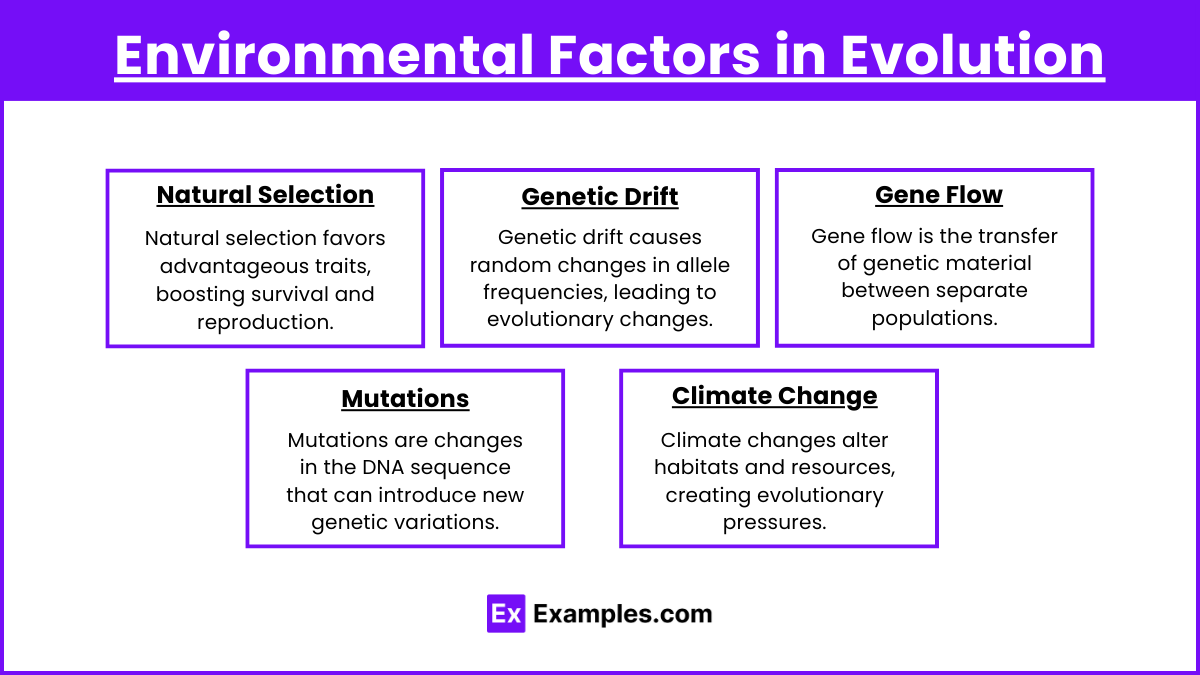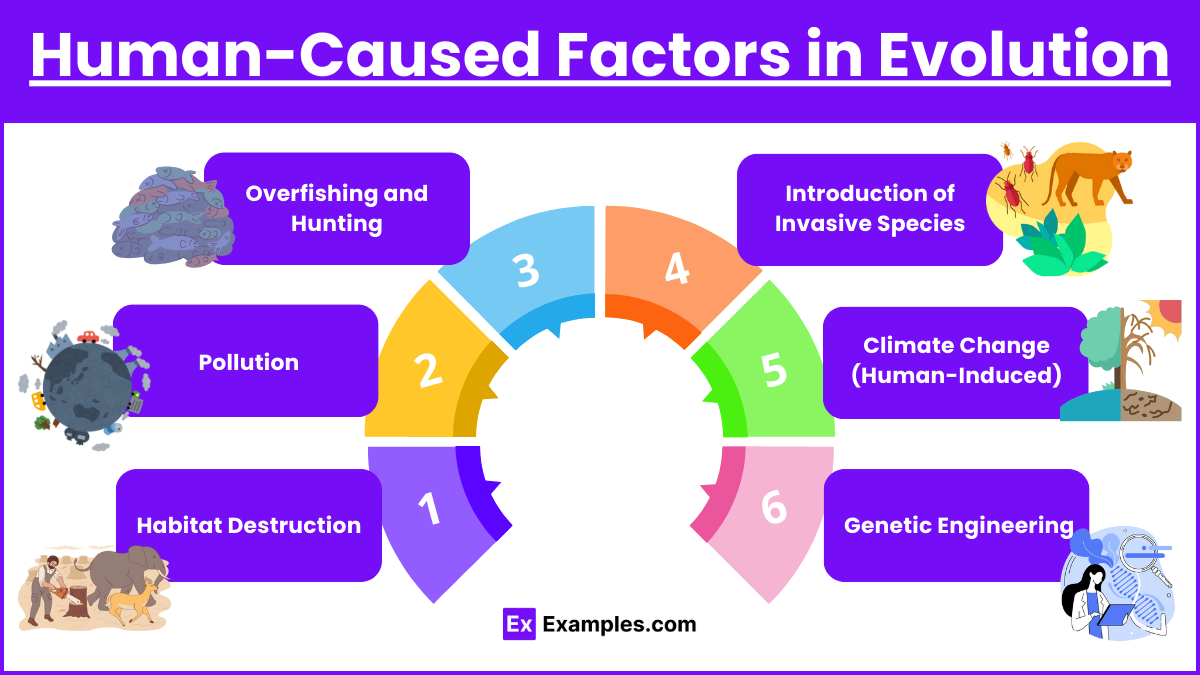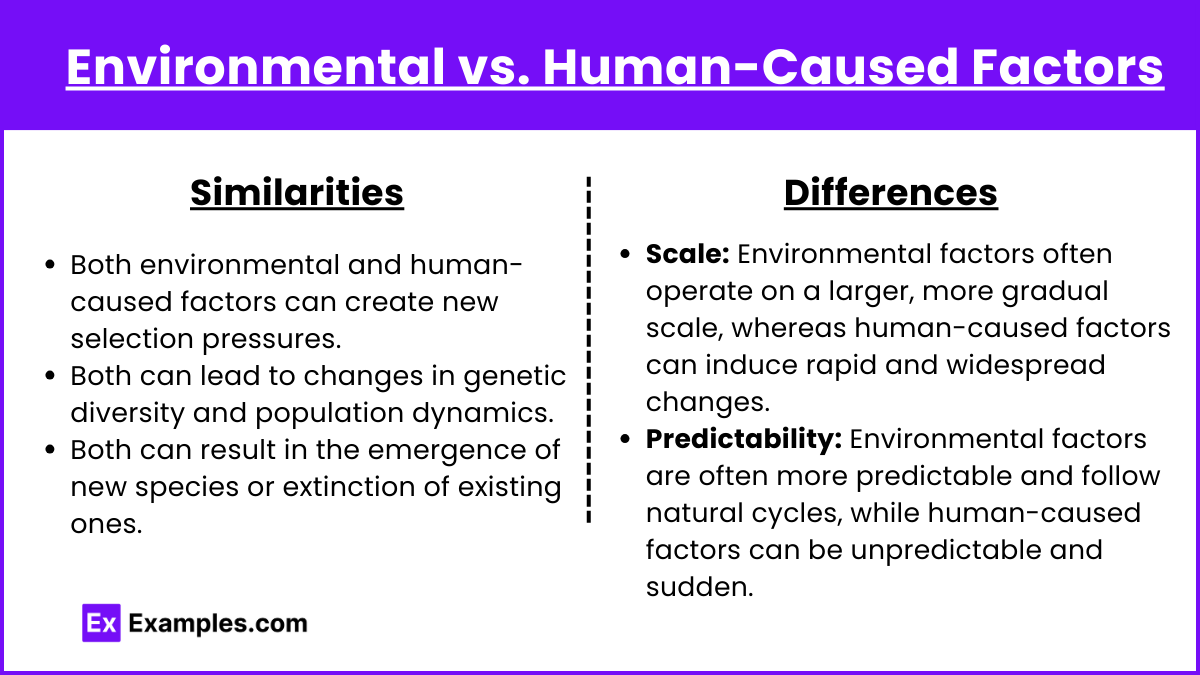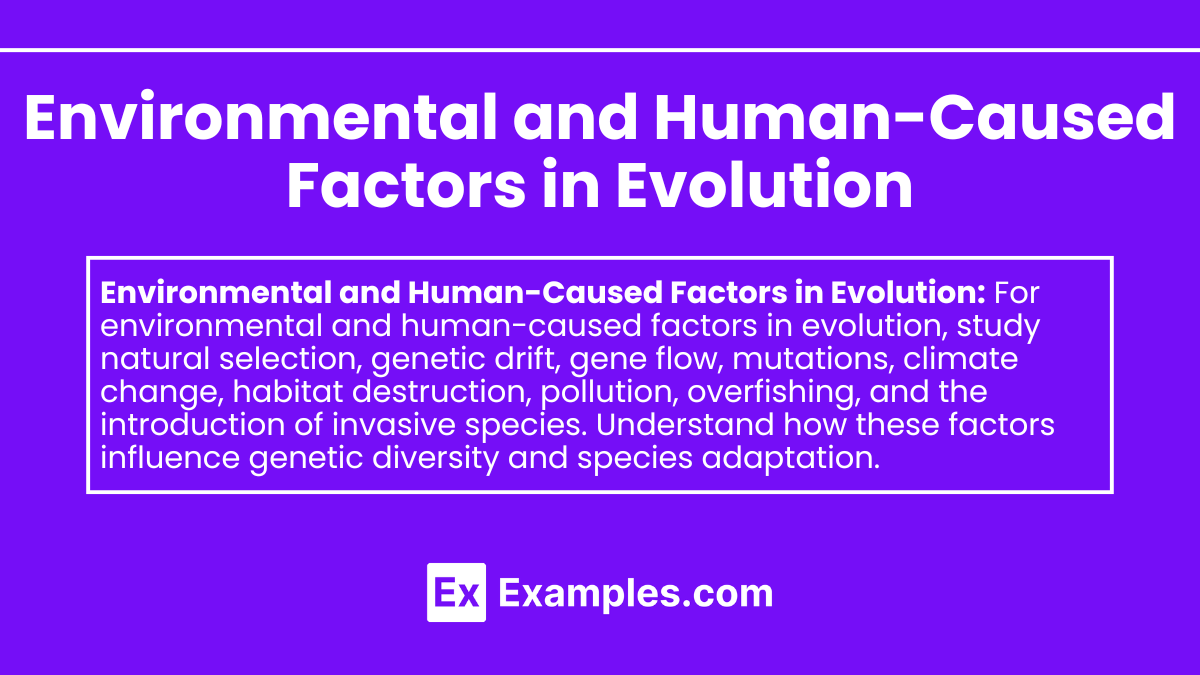In AP Biology, understanding the environmental and human-caused factors in evolution is crucial. These factors drive genetic changes in populations over time. Environmental influences include natural selection, genetic drift, and climate change, while human activities such as habitat destruction, pollution, and overfishing create new selection pressures. Both sets of factors shape biodiversity and the emergence of new species, providing key insights into evolutionary mechanisms and their impact on the natural world.
Learning Objectives
By studying Environmental and Human-Caused Factors in Evolution, you will understand how natural selection, genetic drift, and climate change drive evolutionary processes. You will analyze the impact of human activities like habitat destruction, pollution, and overfishing on genetic diversity and species adaptation. By mastering these concepts, you will be able to explain the mechanisms of evolution, evaluate the consequences of human actions on ecosystems, and appreciate the complexity of biodiversity.
Environmental Factors in Evolution

Environmental factors encompass natural elements and processes that impact the survival and reproduction of organisms. These factors include:
Natural Selection
- Definition: Natural selection is the process where organisms with favorable traits are more likely to survive and reproduce, passing those traits to the next generation.
- Example: Peppered moths in England during the Industrial Revolution. Dark-colored moths had a survival advantage in polluted areas, leading to an increase in their population.
Genetic Drift
- Definition: Genetic drift refers to random changes in allele frequencies in a population, which can lead to significant evolutionary changes over time.
- Example: The bottleneck effect, where a natural disaster drastically reduces a population’s size, leaving a non-representative sample of the original genetic diversity.
Gene Flow
- Definition: Gene flow is the transfer of genetic material between separate populations.
- Example: Migration of birds from one region to another can introduce new genes to the population, increasing genetic diversity.
Mutations
- Definition: Mutations are changes in the DNA sequence that can introduce new genetic variations.
- Example: The development of antibiotic resistance in bacteria is often due to mutations that confer survival advantages.
Climate Change
- Impact: Changes in climate can alter habitats and the availability of resources, leading to evolutionary pressures.
- Example: Polar bears evolving thicker fur and fat layers to survive in colder climates.
Human-Caused Factors in Evolution

Human activities have significantly impacted evolutionary processes. These factors include:
Habitat Destruction
- Impact: Destruction of habitats reduces the available living space and resources, leading to population declines and changes in genetic diversity.
- Example: Deforestation in the Amazon leads to loss of species and changes in population genetics of surviving organisms.
Pollution
- Impact: Pollution can alter the environment and create new selection pressures.
- Example: Industrial pollutants can cause mutations and affect reproductive success in aquatic species.
Overfishing and Hunting
- Impact: Overexploitation of species can lead to population declines and changes in genetic diversity.
- Example: The overfishing of Atlantic cod has led to a decrease in their population and genetic diversity, impacting their evolutionary potential.
Introduction of Invasive Species
- Impact: Invasive species can outcompete native species, leading to changes in population dynamics and genetic diversity.
- Example: The introduction of the cane toad in Australia has led to declines in native predator species and changes in ecosystem dynamics.
Climate Change (Human-Induced)
- Impact: Human activities that contribute to climate change can alter habitats and create new selection pressures.
- Example: Increased global temperatures due to greenhouse gas emissions affect the distribution and evolution of species like coral reefs.
Genetic Engineering
- Impact: Genetic engineering and biotechnology can directly alter the genetic makeup of organisms.
- Example: Genetically modified crops that are resistant to pests and diseases can influence the evolution of pest species through new selection pressures.
Comparative Analysis: Environmental vs. Human-Caused Factors

Similarities
- Both environmental and human-caused factors can create new selection pressures.
- Both can lead to changes in genetic diversity and population dynamics.
- Both can result in the emergence of new species or extinction of existing ones.
Differences
- Scale: Environmental factors often operate on a larger, more gradual scale, whereas human-caused factors can induce rapid and widespread changes.
- Predictability: Environmental factors are often more predictable and follow natural cycles, while human-caused factors can be unpredictable and sudden.
Examples
Example 1: Natural Selection – Peppered Moths
During the Industrial Revolution in England, the peppered moth population shifted from predominantly light-colored to dark-colored moths. The dark coloration provided camouflage against soot-covered trees, increasing their survival rate.
Example 2: Genetic Drift – Cheetah Population
Cheetahs have very low genetic diversity due to a population bottleneck that occurred around 10,000 years ago. This event drastically reduced their population size, leading to genetic drift and a lack of genetic variation.
Example 3: Gene Flow – European Rabbits in Australia
The introduction of European rabbits to Australia resulted in gene flow between the introduced population and any native rabbit populations. This gene flow increased genetic diversity and contributed to the rapid spread and adaptation of the rabbits.
Example 4: Pollution – Industrial Melanism in Birds
In industrial areas, birds such as the pied flycatcher have evolved darker plumage to better blend in with soot-covered environments. This adaptation is a result of pollution-induced selection pressures.
Example 5: Overfishing – Atlantic Cod
Overfishing of Atlantic cod has led to a significant reduction in their population size. This intense selective pressure has caused evolutionary changes, such as earlier maturation at smaller sizes, as the fish adapt to increased mortality rates.
Multiple Choice Questions
Question 1: Which of the following is an example of genetic drift?
A. The increase in dark-colored peppered moths during the Industrial Revolution
B. The low genetic diversity in cheetahs due to a population bottleneck
C. The introduction of European rabbits to Australia
D. The development of antibiotic resistance in bacteria
Answer: B. The low genetic diversity in cheetahs due to a population bottleneck
Explanation: Genetic drift refers to random changes in allele frequencies, often occurring in small populations. The low genetic diversity in cheetahs is a direct result of genetic drift following a population bottleneck.
Question 2: How does pollution influence evolutionary processes?
A. By causing genetic drift
B. By altering selection pressures
C. By increasing gene flow
D. By reducing mutation rates
Answer: B. By altering selection pressures
Explanation: Pollution can create new selection pressures by changing the environment. For example, industrial melanism in birds occurs due to the need to camouflage against soot-covered backgrounds.
Question 3: What is the primary evolutionary impact of overfishing on fish populations?
A. Increased genetic diversity
B. Increased mutation rates
C. Earlier maturation at smaller sizes
D. Increased population size
Answer: C. Earlier maturation at smaller sizes
Explanation: Overfishing imposes a strong selective pressure on fish populations, leading to earlier maturation at smaller sizes as a survival strategy to reproduce before being caught


